- I Saw You Yesterday/Yours Forever/School Day
The Blue Stars
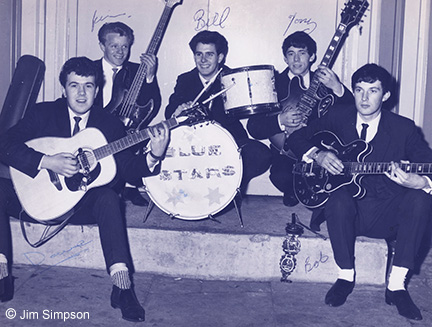
CANNOCK
Updated October, 2018
Dave Bailey lead vocal, guitar
Bob Bowman lead guitar, vocal
Doug Bottom drums (left 1962)
Brian Lunn bass guitar (left 1964)
Tony Phillips rhythm guitar, vocal
Bill Evans drums (joined 1962)
Terry Mew bass guitar (joined 1964)
Jeff Wilding lead vocal
"Old Hill Plaza had a very large dressing room which we shared with The Beatles. We were mainly interested in chatting to John Lennon about his Rickenbacker guitar!"
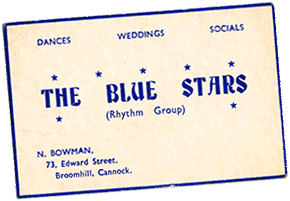
The Blue Stars rhythm group recorded three tracks that were included on a rare LP album titled "Brum Beat" that was issued by Decca Records in 1964. They should not be confused with another 1960s recording group from New Zealand called The Bluestars.
Well known on the famous "Regan Circuit" of venues, The Blue Stars shared billing with The Beatles on three different occasions! BrumBeat contributor Brian Nicholls interviewed Blue Stars lead guitarist Bob Bowman in March 2018 in order to write this previously untold story of The Blue Stars exclusive to the BrumBeat web site as follows;
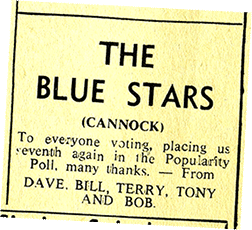
1963 was a pivotal year for British popular music. After a 'fallow' few years for pop (or was that pap?) music, a new musical phenomenon emanating from the North of England called "The Mersey Sound" was happening with a vengeance only to be finally known throughout Britain and the rest of the world as "Beatlemania".
Previously, Britain never did move far enough out of its grand tradition of variety and "all round family entertainers" (Tommy Steele anybody?) to come up with anything that could seriously be said to equal the compelling power and spontaneity of rock 'n' roll in America on anything like a consistent basis.
This "Beat Boom", essentially piloted by The Beatles and The Rolling Stones, was gathering steam and popular music was now again becoming influenced by guitar groups but this time, performing obscure, exciting American soul and rhythm and blues songs with a driving beat in their acts.
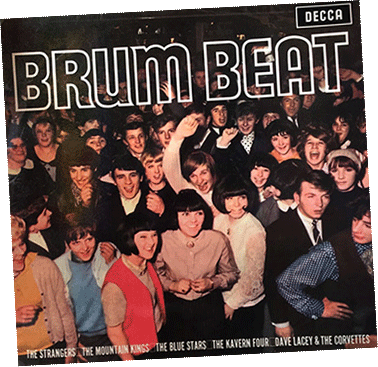
Whilst all this was going on, the talent-hungry London music moguls Norrie Paramor and Les Reed were both separately busy creating "Brumbeat" which they perceived to be an area having a thirty mile or so radius from the Bull Ring. 1964 saw the release of a Les Reed-produced Decca LP (album) called "Brum Beat" featuring five of the area's finest groups and yet, none of them were actually from Brum!
The other three groups on the Decca Brum Beat album were; Dave Lacey and The Corvettes (Stourbridge), The Kavern Four (Cannock), The Mountain Kings (Walsall), and The Strangers (Dudley).
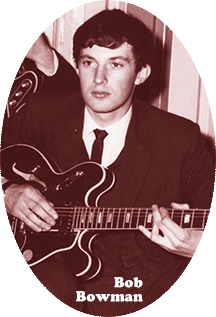
THE BLUE STARS from Cannock were allotted three of the sixteen tracks and, like the other four groups on the Brum Beat album, were all musically adept young lads at the pinnacle of their provincial careers and now looking to that important break into the big time. They were to strike lucky by their ascent to the Mary "Ma" Regan management of the top Midlands ballroom circuit.
Lead guitarist Bob Bowman takes up the story; "We actually formed a 'no name' group around 1958. A lad named Tony Phillips who lived a few doors away from me in Edward Street was playing an electric guitar in his back yard. It was a Hofner Senator guitar plugged into an old valve radio. I bought a Hofner Club 40 guitar and a Watkins 10 watt Westminster amplifier. Hofner was the fallback guitar at the time because you couldn't buy American guitars due to a government embargo-not lifted until 1960."
"we were influenced by Cliff and The Shadows so our name was after a tune we played called 'Blue Star' from The Shads first album"
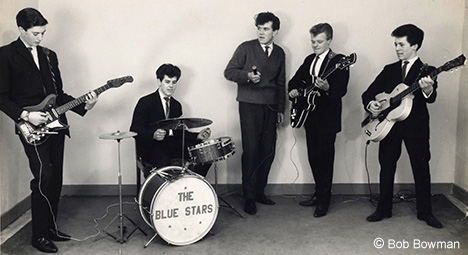
"Our first official line up of The Blue Stars was, Tony Phillips, (rhythm guitar), Brian Lunn, (bass), Doug Bottom (drums), Dave Bailey (singer), and myself (lead guitar). We actually became for a short time "The Blue Stars with Dave & Jerry" (Jeff wilding) because like all groups of the day we were influenced by Cliff Richard and The Shadows so even our name was after a tune we played called 'Blue Star' from The Shads first album in early 1961."
"In fact, a large part of our repertoire was Shadows tunes as well as early Cliff Richard songs from his first three albums. We also admired Joe Brown as a singer/lead guitarist and featured quite a few songs from his first album (A Picture of You). My dad, Jock Bowman, became our manager and he got us loads of bookings (gigs) at the many social clubs that existed around Cannock and farther afield such as, The Watersplash in Walsall."
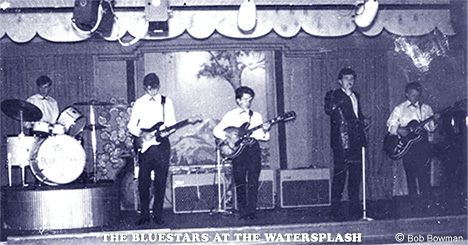
"Very popular clubs were Edward Street Social Club and Mid Cannock Miner's Welfare Club where we had a Tuesday evening residency and Walsall's Redcaps did the Thursday night. The Trafalgar Inn at Hednesford was our Monday evening residency. We also played The Danilo Cinema in Cannock and The Avion Cinema in Aldridge using our small 10 watt amplifiers and the cinemas PA unit. We also played Bloxwich Baths where we opened for Screaming Lord Such in whose band I was later to play after The Blue Stars."
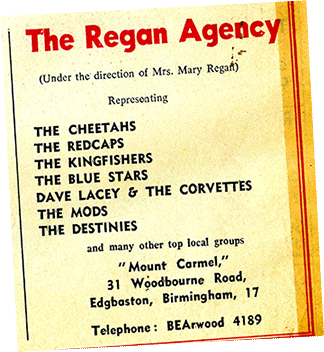
"In 1962 my dad got us into the Ma Regan ballroom circuit which included The Plaza Old Hill, The Plaza Handsworth, The Ritz Kings Heath and, The Brum Kavern Club Small Heath. We also played at an old cinema in Pensnett called The Forum. I recall there being a lot of fights there with people dropping things from the balcony on to the dance floor."
"My dad drove us around in a Bedford van as we were all too young to drive - we were just school kids at the time!! In those early days we did not have a PA system so we ran everything (guitars, bass and microphones) through the Vox amplifiers because each amp had six inputs. Most groups did this at the time and the overall sound in pubs and social clubs was quite good."
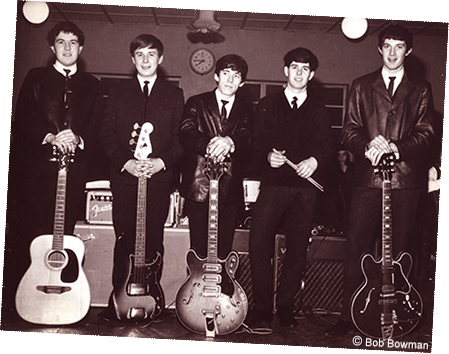
Like all lead guitarists, Bob was never satisfied with his sound until he acquired a Gibson ES 345 Stereo guitar in 1964 which cost him 202 guineas from a London music shop. His original guitar, the Hofner Club 40 was, in 1961, traded in at Harry Parkes' music shop in Walsall for a Burns Tri Sonic made by Jimmy Burns in London. In 1962, that was traded for a two-tone sunburst Fender Stratocaster (like Buddy Holly's) and that for a Gibson 335 in 1963 before finally achieving the Holy Grail of the Gibson 345 in 1964 which he held on to until 1967.
Notwithstanding all this, rhythm guitarist Tony Phillips swapped his Hofner Senator for an American Harmony H75 early in the group's inception and kept it for the duration. The old valve radio was replaced initially with a Vox AC15 and then a Vox AC30 Top Boost amplifier. Along with Bob in 1962, Bob's Watkins amplifier was traded for a Selmer Zodiac early in his career before changing to a Top Boost Vox AC 30 used by just about anybody who was anybody anywhere.
Two young local fans of the group were Pauline Taylor and Marilyn Holmes. Marilyn said; "We were avid fans of the Blue Stars. We went to the Mid Cannock Mining Colliery community centre, the Pye Green Church community centre, the Trafalgar Inn up at Rawnsley and anywhere else they played."
"During those three hectic Regan years we were able to do very little else as we were a semi-pro group and all of us had jobs to hold down"
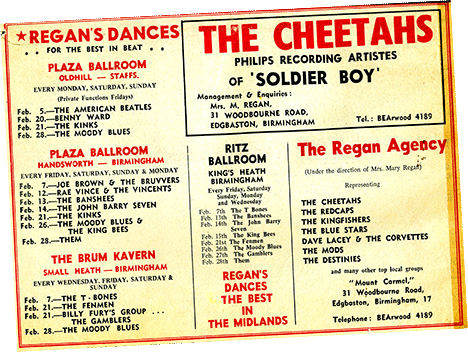
Like all groups, personnel changes are inevitable. Doug Bottom was replaced early by Bill Evans on drums while Brian Lunn left after recording the Brum Beat album to be replaced by Terry Mew. Jeff Wilding who shared the lead singing with Dave Baily left after a short time. Prior to The Blue Stars, Brian, Doug and Jeff had all previously been members of another Cannock group called The Misphits. Bob recalled; "During those three hectic Regan years we were able to do very little else as we were a semi-pro group and all of us had jobs to hold down".
The Blue Stars played the Regan circuit for three years (1962-1965) performing every Friday and Saturday night as well as occasionally on a Sunday. All Regan groups were required to "do a treble" ie playing three spots per night at any three of her four ballrooms. Headline acts were required to "do a double".
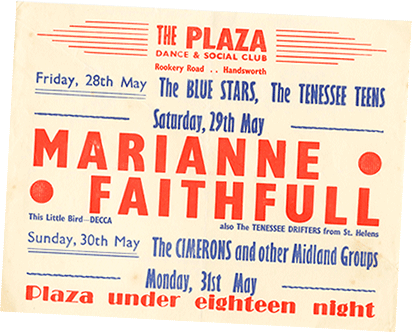
In order to facilitate this almost impossible task, drum kits had to be transported fully assembled in the group van in order to minimise changeover times and disruption to the revellers at each ballroom. Remember, we are talking about a time when ballrooms, town halls and civic halls were the top venues for international artists to perform because, concert arenas and associated sound systems were light years away but, The Blue Stars did more than their fair share in this respect.
Perhaps their highlight was sharing the billing with The Beatles on the three occasions that Bob refers to earlier and although he does not have recollection of the actual dates, he nevertheless recalls the main details.
Bob; "The Ma Regan circuit was a major breakthrough for any local group because not only did we get loads of work from her, we also got the opportunity to meet and share the billing with international stars such as, PJ Proby, Bert Weedon, Johnny and The Hurricanes, Brenda Lee, The Pretty Things, Steam Packet, Howling Wolf, The Swinging Blue Jeans, The Hollies, Lovin' Spoonfull, The Big Three, Freddy and The Dreamers, The Searchers, The Rolling Stones, and, of course, The Beatles with whom we appeared on three separate occasions - once at The Plaza Old Hill and twice at The Plaza Handsworth.
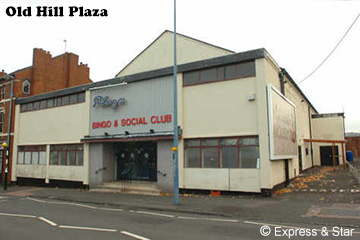
This started in October 1962 at The Plaza, Old Hill when 'Love Me Do' was in the lower twenties of the chart through to 1963 to coincide with the release of their other singles; 'From Me To You', 'Please Please Me' and their first LP in 1963.
Old Hill Plaza had a very large dressing room which we shared with The Beatles. They arrived in long leather coats which they had purchased in Hamburg and were of WWII origin. We were mainly interested in chatting to John Lennon about his Rickenbacker guitar!
"they did around twenty minutes worth of numbers from their new LP and then quickly exited, helped by my dad, via a fire escape across the roof"
Another group did a forty five minute opener after which they did a twenty minutes or so spot and then we finished with another forty five minutes spot. As we we had just started our spot they walked across the front of the stage and down the fire escape.
The dressing room at the Handsworth Plaza was much smaller than Old Hill and The Beatles were now becoming much more popular. The last time we played with them they did around twenty minutes worth of numbers from their new LP and then quickly exited, helped by my dad, via a fire escape across the roof."
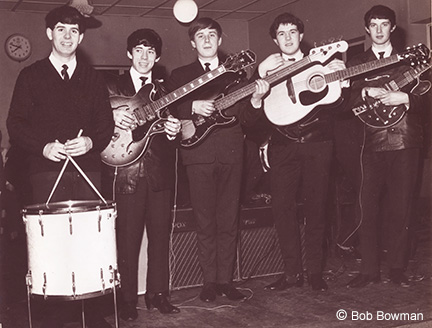
The Beatles were running late this day, Friday July 5, 1963 having come direct from a booking at the Cavern Club in Liverpool and now due at The Plaza Old Hill where support group Denny Laine and The Diplomats were fast running out of numbers to play.
In 1965 when The Blue Stars called it a day and Bob sold everything electrical, bought a Gibson Jumbo acoustic guitar and became a solo artist on the folk club circuit starting with the Trafalger Inn, Littlewood Road, Hednesford where there was an established folk club. Bob, at this time, was an admirer of London guitar luminaries John Renbourn and Bert Jansch and therefore, featured many acoustic fingerstyle guitar numbers in his act.
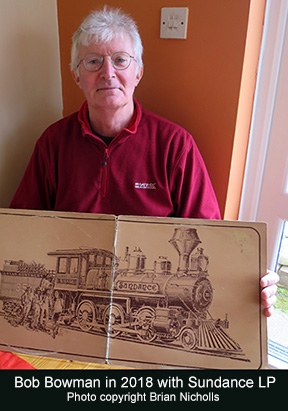
Tony joined The Misphits after leaving The Blue Stars and later, "Ricky and The Rockabouts" before becoming infatuated with Spanish flamenco guitar and he became so proficient that people in Spain can't believe that he is not Spanish. He also teaches Flamenco to this day.
Doug Bottom started his own business, Bill Evans became a postman, Dave Bailey moved to Cornwall. Jeff Wilding moved to America in about 1973 where he was contracted to teach football to youngsters. Sadly, Doug Bottom and Brian Lunn are since deceased.
Bob Bowman became a college lecturer and then went on to be a multi instrumentalist, turned professional and joined the rock group "Sundance" with whom he made two albums for Decca. This band also included drummer Alan Moore who was in an early line-up of Judas Priest.
Bob went on to join The Raymond Froggatt Band and then Billy J. Kramer for short periods, Luv Machine and, Penny Farthing. He has also played on recordings by Deep Purple's Glenn Hughes and renowned Fleetwood Mac guitarist Peter Green.
Over the past two decades Bob has regularly joined forces with singer/songwriter Emmitt Till with whom he still gigs and plays on recordings. As I write, Bob is also very busy with popular local functions band "Play It Again Sam" - check them out on Youtube.
I offer my thanks to Bob Bowman for his valuable assistance In compiling this article and for the supply of associated images.
Copyright © Brian Nicholls 2018
The Blue Stars 1960s Record Releases
Decca "BRUM BEAT" various bands album DECCA LK 4598 (1964):
Brum Beat: 1992 Compact Disc (German re-release of Decca album) - Merseybeat MBRCD0002